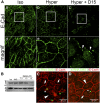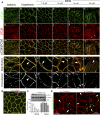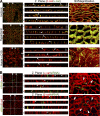Sphingomyelin metabolism is involved in the differentiation of MDCK cells induced by environmental hypertonicity
- PMID: 25670801
- PMCID: PMC4373737
- DOI: 10.1194/jlr.M050781
Sphingomyelin metabolism is involved in the differentiation of MDCK cells induced by environmental hypertonicity
Abstract
Sphingolipids (SLs) are relevant lipid components of eukaryotic cells. Besides regulating various cellular processes, SLs provide the structural framework for plasma membrane organization. Particularly, SM is associated with detergent-resistant microdomains. We have previously shown that the adherens junction (AJ) complex, the relevant cell-cell adhesion structure involved in cell differentiation and tissue organization, is located in an SM-rich membrane lipid domain. We have also demonstrated that under hypertonic conditions, Madin-Darby canine kidney (MDCK) cells acquire a differentiated phenotype with changes in SL metabolism. For these reasons, we decided to evaluate whether SM metabolism is involved in the acquisition of the differentiated phenotype of MDCK cells. We found that SM synthesis mediated by SM synthase 1 is involved in hypertonicity-induced formation of mature AJs, necessary for correct epithelial cell differentiation. Inhibition of SM synthesis impaired the acquisition of mature AJs, evoking a disintegration-like process reflected by the dissipation of E-cadherin and β- and α-catenins from the AJ complex. As a consequence, MDCK cells did not develop the hypertonicity-induced differentiated epithelial cell phenotype.
Keywords: Madin-Darby canine kidney cells; renal epithelial cells; sphingomyelin synthase.
Copyright © 2015 by the American Society for Biochemistry and Molecular Biology, Inc.
Figures







Similar articles
-
Changes in ceramide metabolism are essential in Madin-Darby canine kidney cell differentiation.J Lipid Res. 2017 Jul;58(7):1428-1438. doi: 10.1194/jlr.M076349. Epub 2017 May 17. J Lipid Res. 2017. PMID: 28515139 Free PMC article.
-
Sphingosine kinase and sphingosine-1-phosphate regulate epithelial cell architecture by the modulation of de novo sphingolipid synthesis.PLoS One. 2019 Mar 21;14(3):e0213917. doi: 10.1371/journal.pone.0213917. eCollection 2019. PLoS One. 2019. PMID: 30897151 Free PMC article.
-
Ouabain Modulates the Adherens Junction in Renal Epithelial Cells.Cell Physiol Biochem. 2019;52(6):1381-1397. doi: 10.33594/000000097. Cell Physiol Biochem. 2019. PMID: 31075189
-
Depletion of E-cadherin disrupts establishment but not maintenance of cell junctions in Madin-Darby canine kidney epithelial cells.Mol Biol Cell. 2007 Jan;18(1):189-200. doi: 10.1091/mbc.e06-05-0471. Epub 2006 Nov 8. Mol Biol Cell. 2007. PMID: 17093058 Free PMC article.
-
SGMS2 in primary osteoporosis with facial nerve palsy.Front Endocrinol (Lausanne). 2023 Oct 11;14:1224318. doi: 10.3389/fendo.2023.1224318. eCollection 2023. Front Endocrinol (Lausanne). 2023. PMID: 37886644 Free PMC article. Review.
Cited by
-
A Rheostat of Ceramide and Sphingosine-1-Phosphate as a Determinant of Oxidative Stress-Mediated Kidney Injury.Int J Mol Sci. 2022 Apr 4;23(7):4010. doi: 10.3390/ijms23074010. Int J Mol Sci. 2022. PMID: 35409370 Free PMC article. Review.
-
Changes in ceramide metabolism are essential in Madin-Darby canine kidney cell differentiation.J Lipid Res. 2017 Jul;58(7):1428-1438. doi: 10.1194/jlr.M076349. Epub 2017 May 17. J Lipid Res. 2017. PMID: 28515139 Free PMC article.
-
Hyperosmotic Stress Induces Phosphorylation of CERT and Enhances Its Tethering throughout the Endoplasmic Reticulum.Int J Mol Sci. 2022 Apr 5;23(7):4025. doi: 10.3390/ijms23074025. Int J Mol Sci. 2022. PMID: 35409383 Free PMC article.
-
Sphingosine kinase and sphingosine-1-phosphate regulate epithelial cell architecture by the modulation of de novo sphingolipid synthesis.PLoS One. 2019 Mar 21;14(3):e0213917. doi: 10.1371/journal.pone.0213917. eCollection 2019. PLoS One. 2019. PMID: 30897151 Free PMC article.
-
Bioavailable wine pomace attenuates oxalate-induced type II epithelial mesenchymal transition and preserve the differentiated phenotype of renal MDCK cells.Heliyon. 2020 Nov 18;6(11):e05396. doi: 10.1016/j.heliyon.2020.e05396. eCollection 2020 Nov. Heliyon. 2020. PMID: 33294652 Free PMC article.
References
-
- Ogretmen B., Hannun Y. A. 2004. Biologically active sphingolipids in cancer pathogenesis and treatment. Nat. Rev. Cancer. 4: 604–616. - PubMed
-
- van Echten G., Birk R., Brenner-Weiss G., Schmidt R. R., Sandhoff K. 1990. Modulation of sphingolipid biosynthesis in primary cultured neurons by long chain bases. J. Biol. Chem. 265: 9333–9339. - PubMed
-
- Merrill A. H., Jones D. D. 1990. An update of the enzymology and regulation of sphingomyelin metabolism. Biochim. Biophys. Acta. 1044: 1–12. - PubMed
-
- Slotte J. P. 2013. Biological functions of sphingomyelins. Prog. Lipid Res. 52: 424–437. - PubMed
MeSH terms
Substances
LinkOut - more resources
Full Text Sources
Research Materials

